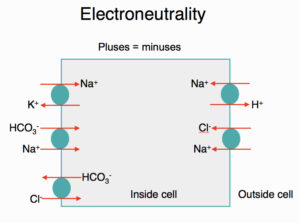The body tries to maintain electroneutrality, where pluses = minuses on either side of the cell membrane, i.e. within the cell, outside the cell and inside the cell versus outside the cell. How cells accomplish this is through transporters, that transport positively or negatively charged molecules inside or outside the cell. So if a plus moves in, a plus must move out. If a minus moves out, a plus must move in. If a plus moves in, a minus can come with it and vice versa to maintain electroneutrality. The kidney is a great example of where this occurs. For example:
1) There is a Na/K transporter that actively absorbs sodium from the tubular lumen into the cell and potassium into the tubular lumen in the distal nephron, under the influence of aldosterone (plus in and plus out); 2) Na is resorbed from the lumen in the proximal tubules with filtered bicarbonate, thus reclaiming filtered bicarbonate (plus in, minus in); 3) A bicarbonate/chloride transporter actively secretes bicarbonate from the renal tubular cell into blood, in exchange for chloride, which moves into the cell from blood (minus out and minus in); 4) A sodium/hydrogen antiporter absorbs sodium from the tubular lumen in the proximal tubules in exchange for hydrogen, which is secreted into the urine (plus in and plus out); and 5) Sodium and chloride can be absorbed together from the tubular lumen (albeit via different transporters than directly linked as shown here) (plus in with minus in). Note, that the depicted events are very simplistic. Often the transporters are linked together, e.g. one provides the energy that drives another. However, the intent is to visualize and explain the concept of electroneutrality.

